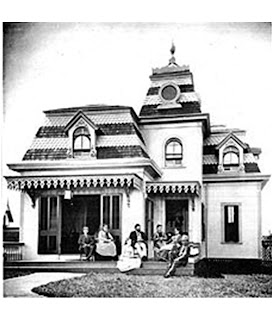Eugene E. Kirby Paved First Roads in Foxboro and Drove First Automobile From Oak Bluffs to Gay Head
 |
| Typical Motorized Conveyance1912 Foxboro and Oak Bluffs |
Every
day and every evening thousands of vehicles drive over the paved and electric
night lighted streets of Foxboro. Nary is a thought given to the time when
these same roads were unpaved and illuminated by gas lamps, and traveled upon
by horse driven wagons and carriages. As when Foxboro’s gravel and cobblestone
roads gave away to paved streets, so there was also a time when gas lamps were
converted over to electric lights. We take for granted many of the modern
conveniences in our present time. However, the historical events of paved roads
and electric lights did not take place in a vacuum. There was an individual
charged with the responsibility to oversee this transformation and that person
was Foxboro’s Eugene E. Kirby.
However,
Eugene was much more than the youth who worked each night lighting the gas
lamps and later supervised the construction of Foxboro's first paved roads.
Foxboro was his consuming love. He lived his entire life, three months shy of a
hundred years, in Foxboro. Eugene was truly a New England neighbor, friend,
entrepreneur, public servant, parishioner, son, husband, father, and
grandfather in every sense and every way.
Eugene
E. Kirby was born in Foxboro on December 25, 1865, the son of Jeremiah and Mary
(McFarland) who were natives of Ireland. Jeremiah was born in County Kerry, but
in early life crossed the Atlantic and established his home at Millville, Rhode
Island, where he resided for a year and a half. He then came to Foxboro, where
he engaged in railroad work throughout the remainder of his life. He passed
away on May 3, 1915, having for a decade survived his wife, who died in March,
1905.
Eugene
was Vincent M (Vin) Igo, Jr.’s grandfather. Vin, “Mr. Foxbro” (Vin’s Massachusetts
vanity license plate) is fondly remembered. Vin worked
for the Foxboro Company from 1943 to 1990. He was a former assistant to the
publisher and up until his death a contributing writer and news photographer
for the Foxboro Reporter where readers had been “Going Along With Vin Igo” for
decades. In 1976 Vin’s old High School was named the Vincent M. Igo School Administration
Center and in 1995 it was changed to the Vincent M. Igo Elementary School.
According
to his obituary Eugene served a total of twenty years as “Superintendent of
Streets” and retired in 1946 at the age of 78. He guided the department from
the horse-drawn days to the motorized equipment and he built the first hard
surface roads in Foxboro. Eugene spent his youthful days under the parental
roof and pursued his education in the schools of Foxboro.
In
November, 1888, Eugene married Ann C. Barton, a daughter of Andrew and Julia
Barton, who were also natives of Ireland. They came to America in early life
and established their home in East Foxboro, where the father worked on the
railroad section for a number of years. He and his wife’s remaining days were
passed in Foxboro. Eugene and Ann became the parents of three children, Mildred
(Vin’s mother), Eugene E. Kirby, Jr. and Sumner B. Kirby.
During
the 1880's Eugene ran one of the largest horse livery stables in New England. He
established a livery partnership with Charles C. Sumner. The “Cohasset Stables”
became known as the firm of "Sumner and Kirby.”
Each
summer he took 27 horses aboard a Woods Hole ferry for the trip to Oak Bluffs on
Martha's Vineyard Island where he operated another livery business for
transportation by summer residents. In 1915 he sold the livery enterprise and
turned his attention to the growing new automobile industry in Oak Bluffs and
in Foxboro. Eugene is credited with driving the first automobile from Oak
Bluffs to Gay Head where an Indian reservation was then located.
Eugene
E. Kirby belonged to several fraternal organizations, having membership with
the Ancient Order of United Workmen, the Benevolent Protective Order of Elks
and the Loyal Order of Moose as well as with the Knights of Columbus. His
religious faith was Catholic and was a “loyal and unfaltering” member of the
Democrat Party.
The
archive of the Foxboro Reporter provides insight into the character Eugene and
several historical vignettes merit recalling. The February 28, 1903 edition
reporting on the Cocasset Stables stated, “Hundreds of people in Foxboro have
enjoyed sleigh rides in the winter and barge rides in the summer with Eugene
holding the ribbons."
Additionally,
in the June 16, 1917 edition, a letter to the editor signed ‘A Subscriber’ stated,
“In these days of selfishness and trouble, it does one's heart good to see a
real charitable act performed. On Sunday last, after services at the Foxboro
Catholic Church, many people stood on the Church steps waiting for a letup in
the storm. Mr. Kirby, townsman and member of the church, was there with one of
his machines. He kindly offered his services to see all reached home safely, making
several trips to different parts of the town and refused utterly any reimbursement
for his trouble."
The
familiar, cheerful, and portly man with white hair who renewed his auto license
every year until the age of ninety-six passed away on September 23, 1965, at
the age of ninety-nine years and nine months.
Eugene
E. Kirby's life gently affected not only the people he loved and came in
contact with, but every aspect of the life of the town he was born, lived and
died in whether it private, public, religious, social or business.
As
time moves forward and generations live and die, there will always be
innovations and inventions to better the quality of daily living. But the
virtue of human kindness transcends death and will be shared by all who
discover and live it.











